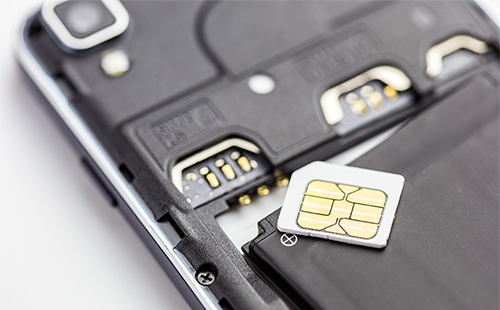How banks can detect and take control of SIM swap fraud

Many financial institutions struggle to safeguard customers against SIM swapping, despite how prevalent this rising form of fraud has become.
In this post, we'll explore what SIM swap fraud is and how a SIM swap service for banks can strengthen fraud protection efforts.
What exactly is SIM swapping?
SIM swapping is a rising form of mobile fraud that targets a victim's phone number. It combines fraudulent techniques like social engineering and phishing to take advantage of one of the most popular forms of mobile security in use today: one-time passwords (OTPs).
The ultimate goal of SIM swapping is to have the victim's phone number moved from their SIM card to a SIM card in the fraudster's possession. If successful, all text messages and phone calls that are intended for the victim are instead sent to the fraudster. This allows the fraudster to make purchases with the victim's funds, hack into the victim's financial accounts, and more, all by using OTPs.
To move a victim's phone number from their SIM card to the fraudster's SIM only requires being able to convince the victim's telecom provider that they are the original SIM owner. Using social media, phishing, and other techniques, the fraudster can gather information like passwords and security question answers. With this information, they can pose as the victim, persuading the telecom provider to switch the phone number to the fraudulent SIM.
Why is SIM swapping on the rise?
SIM swap is a valuable means for a fraudster to gain access to victims accounts quickly, with a much lower requirement and risk than perhaps going into a bank to take money directly. This is one of the key reasons behind the rise in SIM swapping.
Fraudsters look to exploit vulnerabilities in the account management of telecoms subscribers, which allows them to conduct the whole fraudulent process entirely online, all while remaining anonymous.
What are the risks for consumers?
The risks for consumers include loss of finances, account takeover, and even identity theft. Because one-time passwords are extremely popular with banks, consumers, and businesses of all varieties, there is little fraudsters can't do once they have access to a person's OTPs.
The only way for consumers to protect themselves against SIM swap fraud is to make it harder for fraudsters to gather the information necessary to pose as the victim, which could stop a SIM swap attack before it even began. However, as the majority of consumers are not aware of the risk, they don’t know that they should be taking precautions against SIM swap fraud.
How should bank tackle SIM swap fraud?
Although banks aren't directly at fault for the rise in SIM swap fraud, it's their customers that are being affected. As such, banks must do everything they can to protect their customers’ data and their financial resources.
Specifically, financial institutions can safeguard against SIM swap fraud by implementing security checks that occur before an OTP is ever sent to a person's phone number. These checks can take advantage of available mobile data, like the SIM swap history of a phone number, detecting SIM swaps and raising red flags. These measures prevent OTPs from falling into the hands of fraudsters, improving a bank's security and reputation.
How can banks get access to customers' mobile data without putting them at risk?
The immediate challenge for banks is that the necessary data currently belongs to mobile operators. This means that for financial institutions to be able to implement these kinds of security checks, they need to form partnerships with mobile operators.
Fortunately, these kinds of partnerships are increasingly possible. Banks and mobile operators can use APIs to protect customer data, allowing them access to the information they need without transferring mobile data to the bank.
Banks can also work with mobile security platforms, like JT's SIM Swap Service, which run all of the required background checks to confirm whether a SIM has been swapped. Institutions that partner with JT will have access to the customer data they need, protecting their customers against SIM swap fraud without adding any unnecessary risks.
How can banks spot vulnerabilities?
JT's SIM Swap Service is fully automated. So, every step of the process, from checking a phone number for a SIM swap, discovering a swap, notifying the bank of the swap, and stopping the transmission of an OTP, happens in a matter of seconds. Relying on this technology means that banks themselves don't have to spot SIM swap vulnerabilities, only respond to them.
How can banks block fraudsters and notify their customers of an attack?
Partnering with a SIM swap service is one of the surest ways for banks to stop fraudsters and keep customers updated on their security. These services can immediately notify the bank when a customer's number is at risk for SIM swap fraud, allowing for efficient and timely response.
First, the bank can automatically block a customer from receiving OTPs if they're determined to be at risk for SIM swap fraud — this prevents sensitive data from ever falling into the wrong hands. Second, an automated email can be sent to the customer telling them why they aren't receiving an OTP and asking them to contact the bank at their earliest convenience.
From there, a bank can work with the customer and their mobile operator to ensure utmost account security. This blocks the fraudster from getting into their account and provides the customer with the information they need to get the situation back under control.
How can banks and mobile operators adapt their authentication processes?
Strengthening the authentication process begins with mobile operators. Telecom companies need to educate their staff on SIM swap fraud, as well as create new security checks that are harder for fraudsters to bypass.
For banks, working with mobile operators and services like JT's SIM Swap Service will strengthen their authentication measures. While OTPs are a step in the right direction, they aren't strong enough on their own to ensure customer safety. Working directly with a SIM swap service makes it possible for banks to maintain a strong authentication process. With these security structures in place, banks can provide their customers with a more secure, reputable service.
 To learn more about SIM swap fraud and how banks can protect their clients from it, get a free copy of our latest eBook: the top 3 banking use cases you should check for SIM swap fraud.
To learn more about SIM swap fraud and how banks can protect their clients from it, get a free copy of our latest eBook: the top 3 banking use cases you should check for SIM swap fraud.
Categories




